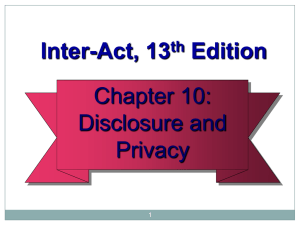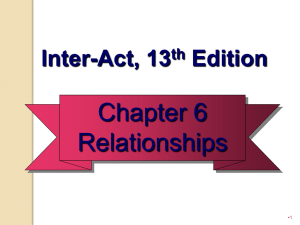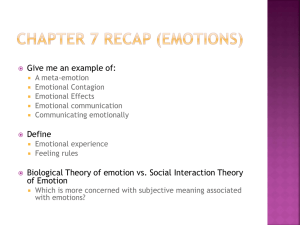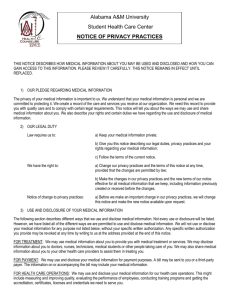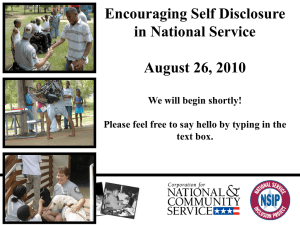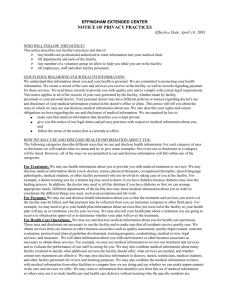Chapter10_Disclosure and Privacy
advertisement
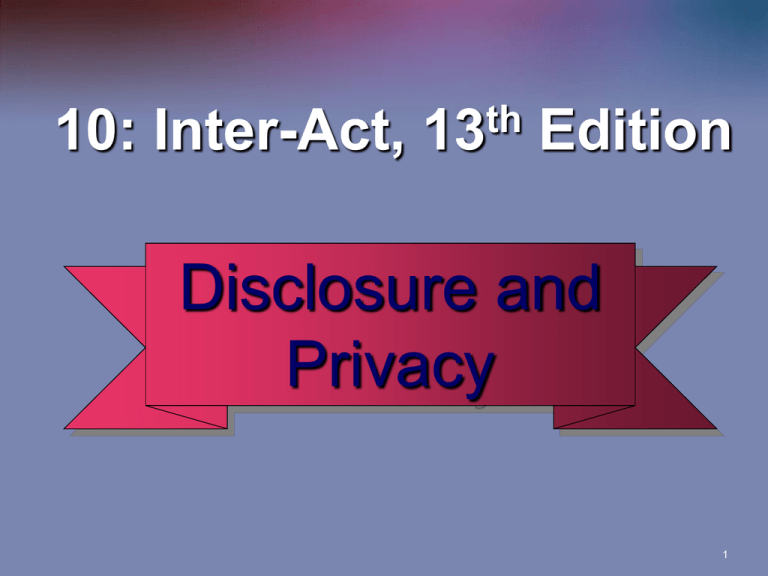
10: Inter-Act, th 13 Edition Disclosure and Privacy 1 Self-Disclosure Revealing confidential or secret information Privacy Withholding personal information to enhance autonomy or minimize vulnerability 2 The Disclosure–Privacy Dialectic The tension between sharing personal information and keeping personal information confidential – also called the openness and closedness dialectic 3 Communication Privacy Management (CPM) Theory • CPM: provides a framework for understanding the decision-making process people use to manage disclosure and privacy • Rules designed to maximize benefits of disclosure while minimizing risks 4 Petronio’s 5 Disclosure Principles 1. Private information is “owned” and people believe they have the right to control it. 2. Control is accomplished through privacy rules. 3. When private information is disclosed, the recipient becomes co-owner of the information. 4. Third-party access concerns • Permeability: how much can be told • Linkage: who else can know • Ownership: who makes third-party disclosure 5. We are likely to encounter boundary turbulence, privacy violations, intrusions, and dilemmas. 5 Factors in CPM Theory Rules • Culture • Individualistic cultures value privacy more than collectivist cultures. • Americans tend to disclose more than most cultures. • Gender • Men tend to disclose less: “strong and silent” type. • Women tend to disclose more: “nurturing and sensitive” type. 6 Factors in CPM Theory Rules • Motivation • Disclose more to people we know or want to know • May disclose secrets of those we don’t like • Risk–benefit analysis • Weigh the advantages/disadvantages of disclosing • Context • Disclose to a “professional” • May “tell” when another is in danger 7 Social Penetration Theory Over time relationships move from lesser to greater intimacy based on the increasing number of topics that partners discuss and the degree of personal information disclosed on those topics (Altman and Dolman). 8 Effects of Disclosure and Privacy on Relationships • Disclosing secrets may damage/end relationship. • Partners don’t disclose at the same time/rate. • Disclosing to a third party may damage trust. • Some may choose to protect others by not disclosing information. 9 Effects of Social Media on Privacy • Social media and cell phone use in public blur the distinction between public and private communication. • Social media and the Internet are changing what people view as private and public. 10 Warranting Theory • We use Facebook pages to create perceptions of others: • Tags • Posts • Blog comments • Warranting theory: We find behaviors of others more credible when it cannot be easily manipulated by the person whom it describes. 11 Digitally Managing Your Personal Information • Do not carry on private phone conversations in public places. • Do not post information online that you would not want your employers, enemies, or identity thieves to see. • Be aware that others can digitally alter your digital image. • Use social media privacy settings. 12 Appropriate Self-Disclosure •Self-disclose the kind of information you want others to disclose to you. •Self-disclose more intimate information only when you believe the disclosure represents an acceptable risk. •Continue intimate selfdisclosure only if it is reciprocated. •Move self-disclosure to deeper levels gradually. •Reserve intimate or very personal selfdisclosure for ongoing relationships. 13 Reciprocal self-disclosure has the greatest positive effects. 14 Skills for Self-Disclosure and Privacy Management • Owning feelings and opinions • Crediting yourself for feelings and opinions • Making “I” statements • Describing behavior and feelings • Recounting specific behaviors without drawing conclusions • Owning and explaining emotions 15 Describing Feelings Explaining emotions one feels in a precise and unemotional manner Displaying Feelings Showing emotions through facial reactions, body language, or paralanguage 16 Protecting Privacy Making a conscious decision to withhold information or feelings from others • Change the subject. • Mask feelings. • Tell a “white lie.” • Establish boundaries. 17 Giving Personal Feedback Describing Behavior Constructive Criticism Recounting specific behaviors of another without commenting on appropriateness Describes the negative behaviors of another and their effects 18 Describing Behavior • Identify the overall impression you are experiencing. • Recall the specific behaviors that led to the impression. • Form a message to report only what you have seen or heard without drawing a conclusion about the behaviors. 19 Giving Constructive Criticism • Begin by describing the behavior. • Preface a negative statement with a positive one. • Be as specific as possible. • Suggest how the person can change the behavior. 20 Praising Describing specific positive behaviors or accomplishments of another and the effects of the behavior 21 Asking for Feedback • • • • • Think of feedback as in your best interest. Be prepared for an honest response. Specify the kind of feedback you are seeking. Avoid loaded questions. Try to avoid negative verbal and nonverbal reactions to feedback. • Paraphrase what you hear. • Show gratitude for the feedback. 22
